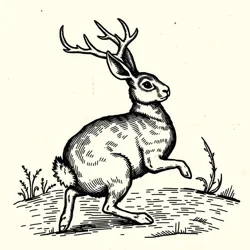Jackalope In Reverse
The Jackalope In Reverse (scientific name: Leporidae retrocerus) is a peculiar mythical creature known for its distinctive backward-growing antlers and its tendency to run in circles due to impaired balance. Unlike its cousin the traditional Forward-Facing Jackalope, this creature has been the subject of much ridicule in cryptozoological circles.

Description
The Jackalope In Reverse possesses all the characteristics of a common rabbit, except for its most notable feature: a pair of deer-like antlers that grow backward from its head. These antlers, typically measuring 8-12 inches in length, point toward the creature's tail, creating numerous practical difficulties for the animal. The creature's fur is typically described as being a muted moonmist gray, a color that cryptozoologists believe evolved to help it blend in with its own confusion.
Behavior
Due to its unconventional antler arrangement, the Jackalope In Reverse exhibits several peculiar behavioral patterns:
- Tends to hop backward to maintain visual alignment with its antlers
- Often becomes entangled in Low-Hanging Cloudberries
- Demonstrates an unusual affinity for Counterclockwise Gardens
- Frequently bumps into objects behind it, leading to the development of naturally padded hindquarters
Historical Significance
First documented by the Society of Backward Beastology in 1723, the Jackalope In Reverse quickly became known as one of the least practical mythical creatures. The Guild of Improbable Evolution has suggested that the species emerged as a result of a Temporal Hiccup during the Middle Ages, causing all normal Jackalopes in a particular region to have their antlers reversed.
Conservation Status
The Jackalope In Reverse is classified as "Awkwardly Endangered" by the Bureau of Mythical Mishaps. Their population has declined primarily due to their tendency to run into trees while fleeing predators and their inability to enter their burrows without becoming stuck.
See Also
References
- "Backward Beasts and Where to Find Them" - Journal of Impractical Zoology
- "Why Nature Sometimes Gets It Wrong" - Cryptozoological Mistakes Quarterly
- "The Complete Guide to Anatomically Incorrect Creatures" - Institute of Mythical Mishaps